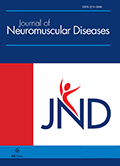Authors: Geuens, Sam | Goemans, Nathalie | Lemiere, Jurgen | Doorenweerd, Nathalie | De Waele, Liesbeth
Article Type:
Research Article
Abstract:
Background: Patients with Duchenne muscular dystrophy (DMD) face a higher risk of neurobehavioral problems, yet an international consensus on screening, assessing, and managing these difficulties is lacking. Objective: This report introduces the term Duchenne Muscular Dystrophy-Associated Neurobehavioral Difficulties (DuMAND) to comprehensively cover the spectrum of neurobehavioral issues in DMD patients, including behavior, psychiatric disorders, and various cognitive, academic, and psychosocial deficits. To facilitate screening, the DuMAND Checklist, a 43-item tool with five subscales, was developed. Methods and results: DuMAND categories were derived through literature review, parent (48 mothers and 37 fathers), and expert (n = 28) input
…and feedback. The DuMAND Checklist subscales were developed iteratively, incorporating item selection, expert panel (n = 10) assessment for face validity, comprehensiveness, and a pilot validation study in a DMD sample (n = 20). DuMAND encompasses five categories: cognition and learning, social responsiveness, emotion regulation, externalizing behavior, and eating and sleeping . Preliminary validation of the DuMAND Checklist indicates acceptable-to-excellent internal consistency and construct validity. Conclusion: By introducing the DuMAND concept, this study seeks to inspire a consensus approach for screening, assessing, and managing neurobehavioral issues in DMD. Incorporating screening, using the DuMAND Checklist, in addition to medical follow-up will facilitate early intervention, addressing a critical gap in identification of neurobehavioral disorders in DMD. Future research is needed to further evaluate psychometric properties of the DuMAND Checklist and investigate the natural course of DuMAND.
Show more
Keywords: Duchenne muscular dystrophy, neurobehavioral problems, screening
DOI: 10.3233/JND-240012
Citation: Journal of Neuromuscular Diseases,
vol. 11, no. 4, pp. 801-814, 2024





